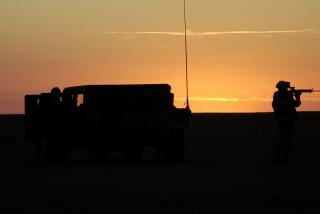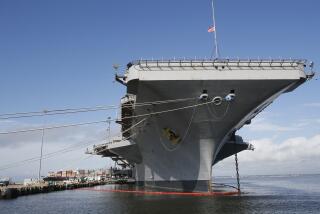Seabees Keep Their Fighting Spirit
- Share via
RAMADI, Iraq — Members of the Seabees, the Navy’s construction force, were fixing broken doors at an empty courthouse here when one looked out a window and saw a group of Iraqi women eyeing the building.
“I wonder if they’re getting ready to call in a sniper,” said John Weissgerber, 28, of Rockville, Md., who was attending college before his reserve unit was called to active duty several months ago.
He was only half-joking.
The force, made famous by John Wayne’s 1944 classic, “The Fighting Seabees,” came to rebuild roads, schools and other infrastructure but has discovered that in Iraq, guns are as important as their hammers, saws and other equipment.
The Seabees here work under constant threat of snipers, roadside bombs and suicide attacks. Members wear side arms and keep their rifles handy while doing their hammering and sawing.
Ten Seabees have been killed in Iraq. Dozens more have been wounded.
The force is supervising more than $130 million in construction contracts awarded to Iraqis. They are also fortifying U.S. bases, improving living quarters for U.S. personnel, installing armor on Humvees and running an apprentice program for Iraqis.
Components of three reserve and two active-duty Seabee battalions are deployed in Iraq, but the number of Seabees here is classified.
Although the force’s motto is “We build, we fight,” some Seabees are surprised at how dangerous the deployment has been. “I didn’t think we’d be this close to the action,” Weissgerber said.
Security has become a major concern. “We improvise, we overcome, we don’t take ‘no’ for an answer,” said Cmdr. Michael Weaver, operations officer for the Seabees. “We’re not going to sit here and let the insurgents rule.”
The Seabees are mindful that restoring power, water and sewer systems is crucial to improving the lives of ordinary Iraqis.
The courthouse they are working on in Ramadi, capital of tense Al Anbar province west of Baghdad, is covered with dust. Windows are broken, and the walls and floors are cracked.
“Back in the United States, this building would be condemned,” said Larry Brock, 46, a construction inspector in Chesterfield County, Va. Brock and the other Seabees on the court project are with Naval Mobile Construction Battalion 23, a reserve unit from Ft. Belvoir, Va.
The courthouse is located on a wide avenue across from a building used by Marines as an “overlook” post. Two powerful insurgent bombs shattered much of the Marines’ outpost shortly after they moved in.
This week, a squad of Marines guarded the Seabees working on the courthouse. Inside, a Seabee put down his hammer and power tools and stood guard with his M-16.
In less turbulent areas of the country, Seabees have repaired scores of schools and public buildings. But in the Sunni Muslim heartland, where insurgents are particularly strong, the Seabees have found themselves more hemmed in.
“Sometimes it seems like we’re just spinning our wheels,” Brock said. “But when you look at the big picture, I think we’re making some progress.”
Renovating the courthouse is a step in helping the Iraqis reestablish a civil and criminal court system. On Sunday, the building was used as a polling place. Before voters were let in, however, Marines kicked down the doors to search for guerrillas and booby traps.
A judge came to the building later in the week. He was ready to work but left after he saw the damage done by the Marines. The Seabees hope the judge returns when the repairs are done.
“The faster we fix things and the faster we help the Iraqi government fix things, the faster we can go home,” said Chief Petty Officer Joe Tkach, who is in charge of the project.
*
Perry is traveling with the 1st Marine Division.
*
(BEGIN TEXT OF INFOBOX)
ÔTo Build and FightÕ
The NavyÕs Seabees have completed a variety of projects since the construction battalions were created in 1941. They build roads, bridges, airstrips and military bases, as well as underwater infrastructure, such as piers and pipelines. HereÕs a look at some of their work:
World War II: About 325,000 Seabees served on six continents and more than 300 islands, building airstrips, bridges, roads, warehouses, hospitals, gasoline storage tanks and housing.
Korean War: Provided pontoon causeways within hours of initial landings at Inchon. Constructed Cubi Point Naval Air Station in the Philippines.
1955: Began Operation Deep Freeze, deploying each year to Antarctica to build and expand scientific bases and construct a 6,000-foot ice runway on McMurdo Sound.
Vietnam War: Built schools and infrastructure and provided healthcare services.
Post-Vietnam: Built and repaired Navy bases in Puerto Rico, Japan, Guam, Greece, Sicily and Spain.
1971: Began its largest peacetime construction Ñ an 11-year project building the Navy base complex on Diego Garcia atoll in the Indian Ocean.
1991 Persian Gulf War: More than 5,000 Seabees served in the Middle East, building camps and 6 million square feet of aircraft parking.
1992: In Somalia, established base camps at humanitarian relief sites; repaired main supply routes, drilled wells and built a schoolhouse.
1998: After Hurricane Mitch hit Honduras, repaired damaged roads, built bridges, cleared debris and constructed base camps.
Iraq war: Fortifying U.S. bases, improving living quarters for U.S. personnel, installing armor on Humvees and running an apprenticeship program for Iraqis.
Source: U.S. Navy. Graphics reporting by Julie Sheer
More to Read
Sign up for Essential California
The most important California stories and recommendations in your inbox every morning.
You may occasionally receive promotional content from the Los Angeles Times.













